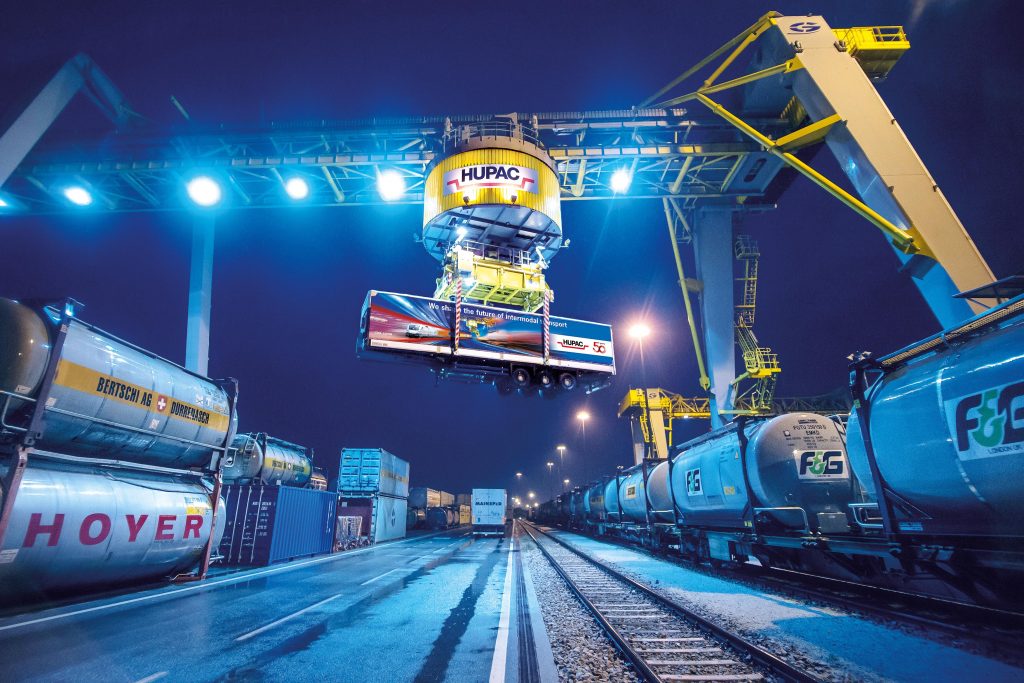Hupac Group: 10% growth in 2019, 40% drop in April 2020

Hupac Group’s has published its annual report. In general, the tone was positive. The year of 2019 produced some impressive figures. The group transferred more than one million truck consignments from road to rail for the first time in its history. It was characterised by growth, which even continued in the first three months of 2020. However in April 2020, a drop of 40 per cent in traffic volumes was recorded due to the closure of factories in Europe.
Despite relatively moderate economic growth in 2019, Hupac was able to increase the number of combined transport consignments by 10.5 per cent to 1,024,089 consignments and group sales by 5.4 per cent to 611 million Swiss francs. This growth was partly due to the acquisition of ERS Railways in June 2018, which last year was consolidated in the Hupac Group for a full year for the first time.
However, 2019 financial year’s result could not keep pace with revenue performance due to the slowdown in the economy, the strong Swiss franc and the reduction in subsidies. Although EBITDA increased by 4.6 per cent or 55.4 million Swiss francs, the operating result of 5.1 million was 35 per cent or 2.8 million lower than the previous year. The factors that contributed were negative cur rency effects of 1million Swiss francs in 2019 and an extraordinary capital gain of 1.9 million Swiss francs from the sale of an investment in 2018.
2020 so far
The current year is putting combined transport to a severe test, Hans-Jörg Bertschi, Chairman of the Board of Directors notes in the report. “At the end of February, the COVID-19 crisis hit Northern Italy – and thus our most important source and destination market – as the first country in Europe with great severity. Hupac reacted immediately and adopted all necessary measures to protect its employees and customers. With the introduction of contactless processes in the terminals in Italy, Hupac has done pioneering work, which has subsequently also benefited the terminals in Northern Europe.”
Nevertheless, the closure of factories made that a slowdown in volumes was inevitable. While initially the traffic volumes iremained high, in April volumes fell to minus 40 per cent. “Hupac subsequently introduced short-time working. The course of business in recent weeks was more or less in line with our COVID-19 crisis plan. The company is financially healthy and has secured additional financial liquidity through its banks in view of a longerterm crisis scenario. Hupac expects a gradual recovery of transport volumes throughout Europe in the second half of 2020”, Bertschi says.
Investments made
Hupac Group has made some significant investments which, according to the report, have “secured its future”. In total, the company invested 75 million Swiss francs in several segments of the railway industry.
32 million of this amount has been invested in rolling stock. At the end of 2019 the Hupac Group operated a fleet of 7,297 wagon modules. Another segment was the investment in transhipment terminals in Italy, the Netherlands, Germany and Poland, which amounted to 38 million.
Terminal strategy
“Terminals are today the Hupac Group’s central strategic investments. In many regions of Europe they are the bottleneck for the further shift of transports over long distances from road to rail. In addition to the new facilities in Milano Smistamento, Piacenza and Brescia to be developed in collaboration with Mercitalia Logistics, Hupac was able to take over the majority of the terminal company CIM SpA Interporto Novara in October 2019”, Bertschi says.
Last year, Hupac also acquired the majority of the terminal company Geleen RTC, near Maastricht in the Netherlands. In addition, in summer 2019 Hupac was able to conclude letters of intent for participation in the construction of new terminals in the former coal port of Duisburg and in Minsk (Belarus).
Outlook
The Board of Directors and the Executive Board assess the prospects for the period after overcoming the COVID-19 crisis as positive. “The finalisation of the 4-meter corridor on the Gotthard axis after completion of the construction work for the Ceneri Base Tunnel and the Bözberg Tunnel creates positive conditions for further developing the trailer segment.
“At the same time, Hupac is further developing the available terminal capacities in the south and north, thereby supporting the climate and eco-friendly transfer policy of Europe and Switzerland. This creates very good opportunities for a further growth phase of combined transport in our core business through the Swiss Alps.
“But we also see exciting opportunities in maritime hinterland transport, with the non-transalpine Shuttle Net and in the Russian and Silk Road transports, to increase sustainable intermodal rail transport in close cooperation with customers”, the chairman concludes.
You just read one of our premium articles free of charge
Want full access? Take advantage of our exclusive offer





